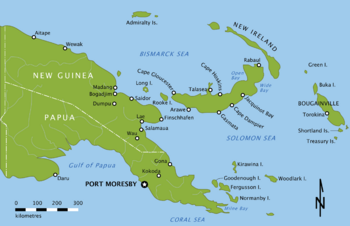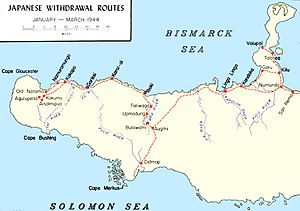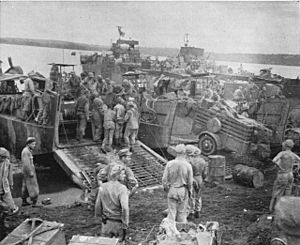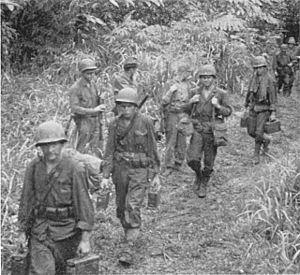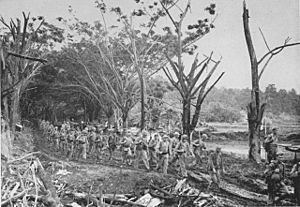Battle of Talasea facts for kids
Quick facts for kids Battle of Talasea |
|||||||
|---|---|---|---|---|---|---|---|
| Part of World War II, Pacific War | |||||||
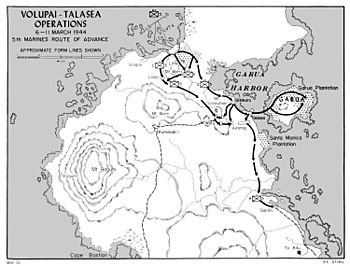 Map depicting the US Marine operation, March 1944 |
|||||||
|
|||||||
| Belligerents | |||||||
| Commanders and leaders | |||||||
| Units involved | |||||||
|
Combat Team A
|
17th Division
|
||||||
| Strength | |||||||
| ~3,000 | 596 | ||||||
| Casualties and losses | |||||||
| 17 killed and 114 wounded | 150 killed | ||||||
The Battle of Talasea was a fight during World War II in the Pacific War from March 6 to 9, 1944. It took place on the island of New Britain in Territory of New Guinea. This battle was part of bigger plans called "Operation Dexterity" and "Operation Cartwheel."
American forces, with some help from Australia, landed on the coast to take control of the Talasea area. This was important because Japanese soldiers were moving away from Cape Gloucester and heading east towards Rabaul. The main group of American soldiers was the 5th Marines. They landed on the western side of the Willaumez Peninsula. Their goal was to move east and capture the emergency landing strip at Talasea. However, a small group of Japanese defenders slowed them down. This meant the American troops couldn't stop the Japanese from retreating from Cape Gloucester as quickly as they hoped.
Before the Battle
Why the Battle Happened
Japanese forces took over the island of New Britain in February 1942. They built a large military base there. This base became a key part of their defenses after they failed to capture Port Moresby in 1942.
The Allies (like the US and Australia) launched attacks at Cape Gloucester and Arawe. These attacks were part of "Operation Dexterity" and "Operation Cartwheel." Their goals were to capture important airfields and open up sea routes between New Britain and New Guinea. They also wanted to cut off the main Japanese base at Rabaul. Instead of attacking Rabaul directly, which would be very costly, the Allies decided to surround it. This would make the base useless.
By early February 1944, US commanders felt confident they would secure western New Britain. They started planning to move east towards Talasea. Talasea had a small airstrip and could be a useful base. This move was meant to follow the Japanese forces who were retreating towards Cape Hoskins and Rabaul.
The plan to take the Talasea area was called "Operation Appease." It involved an amphibious landing, meaning troops would come ashore from the sea. The landing beach was called "Red Beach," near the Volupai Plantation. It was a narrow beach, surrounded by a swamp and a steep cliff. The land behind the beach rose towards Mount Worri. To the east, Mount Schleuther overlooked several villages.
Even with the difficult land on the sides of the beach, there were good reasons to land there. The beach was on the narrowest part of the peninsula, only about 2.5 miles (4 km) from Garua Harbor. A former plantation owner, Rodney Marshland, suggested it as a good landing spot. It offered a fairly flat path to the Marines' targets: government buildings, the Talasea airstrip, and Garua Harbor. Plus, a dirt track from the beach meant vehicles could be used.
Who Fought
The main American force for this operation was called Combat Team A. It was made up mostly of the 1st and 2nd Battalions of the 5th Marines, led by Colonel Oliver P. Smith. They had support from other units, including artillery, engineers, and medical teams. Key support units included the 1st Medical Battalion and two Engineer Boat and Shore Regiments.
The US force had a little over 3,000 ground troops. The total force was about 5,000 people. Most of the landing boats were operated by US Army engineers.
The Japanese defending Talasea had about 596 men. These included soldiers from the 54th Infantry Regiment and a battery of artillery. They also had machine guns and mortars. These troops were part of Lieutenant General Yasushi Sakai’s 17th Division. They were called "Terunuma Force," led by Captain Kiyamatsu Terunuma. Their job was to defend the area to protect the retreat path for other Japanese troops coming from Cape Gloucester.
The Battle Begins
Before the attack, Australian Bristol Beaufort planes bombed the Japanese defenses around the landing beach. On March 3, a small scouting team landed. It included an Australian officer, an American, and two local scouts. They found friendly local people and learned about the Japanese forces. They then returned to their base. The next two days were spent preparing for the battle.
On March 5, 1944, the US force set off from Iboki Plantation. They had a fleet of 60 different landing craft, protected by five PT boats. Four medium tanks were also on board.
The next day, March 6, the landing was delayed because the fighter planes meant to protect them didn't arrive. Colonel Smith decided to go ahead anyway. The first group of 500 Marines from the 1st Battalion, 5th Marines, led the assault. Their job was to create a safe area on the beach for more troops to land.
Because of a coral reef, the first two companies had to use smaller tracked landing vehicles. These vehicles were lowered from larger tank landing craft. As they moved towards the shore, tanks on a medium landing ship fired machine guns to cover them. The Japanese on the beach fired back a little.
As the first two companies landed, a small spotter plane flew overhead. It dropped grenades because the promised air support wasn't there. This unexpected air support was described as "heavy" by the Japanese defenders. The landing was mostly unopposed, with only a few small fights. The Marines set up a beachhead about 200 yards (180 m) inland.
The coral reefs made it slow for boats to come in. They had to sail in a single line. The small landing beach also made unloading difficult. Artillery landing on the beach suffered heavy losses from Japanese mortars. Medical staff on the beach also faced many casualties.
Around 11:00 AM, Company 'E' of the 2nd Battalion began moving through the 1st Battalion. The 1st Battalion had not yet fully secured the plantation edge. One of the four Sherman tanks got stuck on the beach. The other three moved forward to support Company 'E'. They quickly silenced a Japanese machine gun. However, one tank was damaged by Japanese soldiers trying to attach magnetic mines. The tank was temporarily out of action. The other two tanks continued to support the infantry.
The Americans found a map of Japanese defenses on a dead Japanese officer. This was very helpful. Two companies, 'E' and 'G', then gained momentum. By nightfall on the first day, the Marines dug in.
The Japanese commander, Terunuma, wanted to buy time for his retreating forces. He sent another company to reinforce the Talasea defenders during the night of March 6/7. These troops got within 50 yards (45 m) of the 2nd Battalion's positions. However, they pulled back when the Marines attacked early on March 7.
Heavy fighting continued throughout the day as the Americans moved towards the opposite coast. They sent patrols to the hills to protect their sides. As they neared Mount Schleuther, Japanese soldiers tried to cut off the Marines. Company 'E' fired heavily, and Company 'F' was sent to attack the Japanese. They arrived before the Japanese and fired down on them, killing 40 soldiers.
US reinforcements, the 3rd Battalion, 5th Marines, were delayed until the afternoon. They then took over defending the beachhead. The plan to surround the villages of Liapo and Waru had to be changed. Instead, a company from the 1st Battalion went through the jungle towards Liapo. They got lost and had to stop for the night. The 2nd Battalion set up a night defense around Mount Schleuther.
The Japanese in front of the 2nd Battalion's position gathered for an attack during the night, but it didn't happen. On the morning of March 8, Company 'F' attacked but found no Japanese fire. A patrol found 12 dead Japanese. Later, a patrol found a Japanese defense position at Bitokara. The 2nd Battalion tried to advance, but the Japanese quickly retreated again.
Scouts reported that the Talasea airstrip was empty. Company 'F' was sent to secure it. The rest of the 2nd Battalion went back to Bitokara for the night, but Company 'F' stayed at the airstrip. The rest of the 1st Battalion moved towards Liapo to meet its isolated company, guided by a local scout. There was a friendly fire incident when the two groups met. After getting a new guide, the 1st Battalion headed for Waru. They stopped for the night because of difficult terrain.
Heavy artillery and mortar fire were exchanged during the night. But the Japanese defenders slowly slipped away south towards Bola. They had been ordered to retreat by their headquarters. A small group of 100 soldiers stayed behind to delay the US troops on March 9. The Marines attacked Waru the next morning but found the main Japanese positions empty. They captured two soldiers who were too slow to escape.
Later, patrols were sent out. One contacted Company 'F', and another crossed Garua Harbor. They found no Japanese there either. The 5th Marines then began clearing the area. Supply boats were sent to Talasea. The Japanese rearguard retreated to Garilli, about 4 miles (6.4 km) south. They set up another defense line. They had successfully delayed the Marines long enough to prevent them from cutting off the main Japanese retreat route.
What Happened Next
The battle resulted in 17 Americans killed and 114 wounded. About 150 Japanese soldiers were killed. After the landing, the Americans continued to patrol and secure Talasea. They pushed north towards Pangalu, across the peninsula to Liapo and Volupai, and south along the coast.
This action put US forces in a good position to bother the Japanese forces retreating east to Cape Hoskins. The commander of the 5th Marines, Smith, also suggested building a naval base at Talasea. This base would allow PT boats to stop Japanese barges moving between Cape Hoskins and Rabaul.
The US forces had also planned to advance towards Gasmata on the southern coast. They wanted to hold a line between Talasea and Gasmata to isolate Rabaul. However, the advance to Gasmata was canceled. US planners realized the area was too swampy for an airfield. They also worried about attacks from Rabaul during the landing.
After Talasea was captured, the US advance east mostly stopped. Only small patrols continued for a few weeks. In April, the US Army 40th Infantry Division replaced the 1st Marine Division. The Marines had lost 310 killed and 1,083 wounded in the entire campaign. The Japanese had 3,868 killed in action.
Some limited fighting continued. The 40th Infantry Division secured Hoskins Plantation and its abandoned airfield on May 7. After this, there was a quiet period on New Britain. US forces stayed mostly in the western part of the island, while the Japanese held Rabaul. Australian-led local troops continued small operations.
In October–November 1944, the Australian 5th Infantry Division arrived and replaced the 40th Infantry Division. The Australians then began a limited offensive, landing at Jacquinot Bay. They pushed further east on both the northern and southern coasts. However, the Australians also decided to contain the Japanese rather than destroy them. They held a line between Wide Bay and Open Bay.


